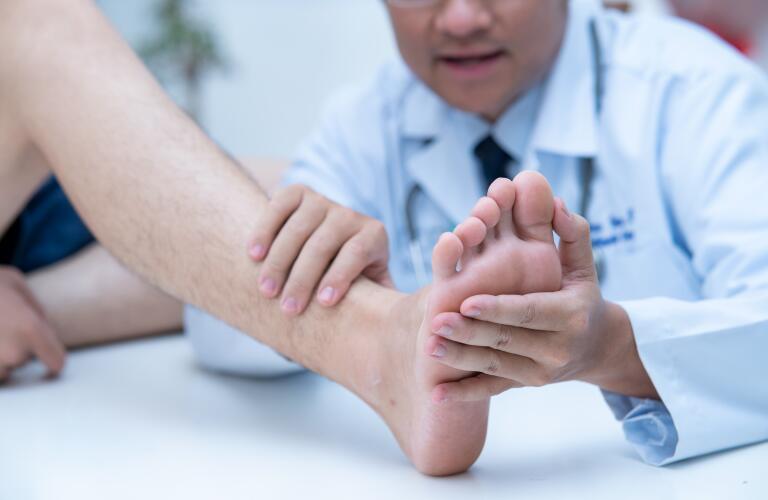Pain and swelling in your foot or ankle are often due to a sprain or strain. These will usually heal on their own, but there are other times you should see your healthcare provider for foot or ankle pain. If symptoms persist or get worse, it could be due to arthritis, a more severe injury, or even conditions like diabetes that need medical management. Here’s how to know when you shouldn’t walk away from seeing a doctor when your feet or ankles hurt.

Aching, stiffness, and swelling in the foot or ankle
Arthritis is common in the feet and ankles and, in addition to the discomfort, arthritic foot and ankle joints can restrict range of motion and movement. Arthritis can develop in the arch, big toe, mid or back area of the foot or ankle. There are nonsurgical and surgical treatments available, depending on the nature and location of the arthritis. Swelling in the feet or ankles can also indicate more serious, if less common problems, like bone or skin infections or heart failure.
Persistent ankle pain
Don’t ignore ankle pain that lasts more than three months, especially if it’s so severe that you feel unstable when you walk. It could be due to injury to a tendon, ligament or bone. You may have bursitis, an inflammation of the joint. Osteoarthritis, rheumatoid arthritis, and gout can also cause ankle pain. Low or fallen arches can also make your ankles hurt. More serious causes include infections like cellulitis or osteomyelitis. Even if the cause is not serious, ankle instability or pain can change the way you walk, which can lead to other problems.
Treatment for ankle pain varies according to what’s causing it, but it’s worth a doctor visit to get to the bottom of it.
Pain on the inside of the foot
If you have fallen arches and your feet tilt outward, you may have a condition called acquired flatfoot. You might feel pain on the inside of your foot, which gets worse when you walk or exercise. Your ankle may also hurt. Acquired flatfoot is often caused by injury to the tendon that connects a calf muscle to bones on the inside of the foot. People with diabetes may also have collapsed arches. Braces or orthotics can help correct the pain, and there are surgical solutions if necessary.
Arch pain
If you have pain in your arch that lingers, you may have a common condition known as plantar fasciitis. The plantar fascia is a band of tough tissue on the bottom of the foot that can become inflamed. A foot doctor can show you exercises, advise you on orthotics, or if it persists, give you a cortisone injection or fit you with a splint. Rarely, surgery is necessary. Other reasons for arch pain include poorly fitting shoes, injury, and obesity. If arch pain lasts more than a few days, contact your healthcare provider for diagnosis and treatment.
Pain in the big toe
If your big toe is inflamed, won’t bend, and locks in place, it could be a condition called hallux rigidus, which can make it hard to even take a step. It is often due to a bone spur at the base of the big toe joint. Treatment includes special shoes that keep your toe from bending. There are also surgical treatment options for hallux rigidus. Gout can also strike the big toe suddenly and painfully. Oftentimes, medication can prevent gout flares, and prescription pain relievers can help if you do get a flare.
Pain in the middle of the foot
Arthritis in the midfoot can make it difficult to climb stairs. You may feel pain when you push off from your toes when you take a step. Another sign of midfoot arthritis is a bony bump on the top of your foot that hurts when your shoe rubs against it. Symptoms develop gradually with time, but midfoot pain is also seen in athletes after a “Lisfranc injury,” which damages the bones or cartilage. Your doctor can advise you on nonsurgical treatments. In some cases, the doctor may recommend fusing the affected joints.
Heel pain
If you have heel pain that doesn’t go away, you may have a heel spur. A spur is a calcium deposit on the underside of the heel bone that can rub against the plantar fascia, the tough tissue on the bottom of the foot. A heel spur can make you feel like you’re stepping on something sharp. Over-the-counter pain relievers may reduce the pain. A doctor can fit you with orthotics or, if necessary, give you a cortisone injection to reduce inflammation. Surgery is rarely needed for heel pain due to bone spurs.
Tingling, numbness or burning feet
Numbness, tingling, and muscle weakness in the feet can be signs of nerve damage, which can be due to an injury, genetics or diabetes. If you have burning pain in the ball of your foot that radiates to your toes, you may have Morton's neuroma. Your third or fourth toe may feel numb. If over-the-counter pain relievers and properly fitting shoes don’t help, a doctor can give you cortisone injections or, if necessary, surgery can relieve the condition.




